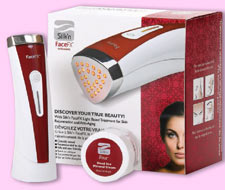
for more youthful, vibrant skin…
Have you noticed that your skin is showing signs of aging? That lines are appearing where once your skin was smooth, and the glow of youth is fading fast?
Although aging is inevitable, looking prematurely old isn’t, and much of the time, the signs we associate with growing older can be put off for a few more years.
The role of collagen
Collagen is a fbrous protein that constitutes the basic building blocks of skin as well as forming the internal “glue” that holds our bodies together. Within the skin, collagen works alongside elastin to provide strength, flexibility, and resilience.
As we age—and particularly if the skin has had exposure to UV light—the collagen scaffolding weakens, causing sagging and wrinkling. For this reason, anti-aging science
focuses primarily on the preservation or restoration of the skin’s collagen.
Introducing
Silk’n FaceFX™
Anti-aging light
Silk‘n FaceFX™ is a light-based anti-aging treatment device for home use. The device uses two processes— fractional red light therapy (Active HF) and deep thermal heating (Deep HF). Active HF technology targets the top layer of the skin, addressing fne lines and pores to improve skin texture, and Deep HF technology penetrates deeper into the skin to address deeper wrinkles and discolouration. By fractionating the energy, Silk’n FaceFX is able to penetrate deeper into the skin without causing discomfort.
Silk‘n FaceFX works by directing heat and light to the dermis. Here, the dermal heating created by infrared light stimulates the collagen and elastin to tighten. This has a rejuvenating effect on the skin. Heating the dermis also stimulates the fbroblast cells to produce new collagen.
The device incorporates a thermostat which monitors skin temperature, and active heating control to ensure a safe heat profle.
People who have used Silk‘n FaceFX report that they noticed improvement in skin texture, pore size, fine lines and wrinkles after using the light for just eight weeks.
Collagen destroyers
Certain lifestyle factors cause collagen to be destroyed at an accelerated pace. These include smoking, exposure to UV radiation (sunlight) and a process known as glycation, caused by consuming certain foods and high sugar levels within the body.
Smoking:
Containing over 4,000 chemicals, inhaled cigarette smoke causes damage to both collagen and elastin. Nicotine is known to constrict blood vessels, which results in the delivery of fewer nutrients and less oxygen. This limitation of nutrients means collagen cannot renew itself expeditiously.
In a 2002 study reported in the British Journal of Dermatology, the rate of synthesis of two types of collagen was found to be 18 and 22 per cent lower in smokers than in non-smokers.i
UV exposure:
Sunlight is extremely damaging to the skin, and this damage is cumulative. UV rays cause free radicals to be created in the skin, which damage both collagen and elastin and accelerate their breakdown.
Glycation:
The process of glycation is caused by the bonding of a sugar molecule with a protein inside the body. In the case of skin, the protein is collagen. This bonding causes the production of advanced glycation endproducts or AGEs within the collagen scaffolding. These in turn cause the collagen to cross-link and become stiff and inflexible. In time, the process of glycation causes sagging and wrinkling.
AGEs can be endogenous (arising inside the body) or exogenous (coming from outside the body). They are more prolifc when levels of blood glucose are high, and are particularly abundant in people with diabetes. Barbecued, grilled, and otherwise browned foods cooked at high heat are a rich source of AGEs and should be avoided if you wish to maintain youthful skin. Since glycation is accelerated in all body tissues when sugar is elevated, it is important to keep dietary sugars to a minimum.
Collagen builders
Just as certain behaviours can destroy collagen, so others can build it. Here are some effective ways to support your skin’s collagen.
Aerobic activity:
Physical activity directs oxygen to the cells, and ensures that blood in the skin’s capillaries delivers this oxygen effciently. Being active also increases growth hormone levels, which contribute to a thicker, more youthful skin.
Vitamin C:
Without this important antioxidant vitamin, your body cannot manufacture collagen. Be sure to get enough by eating foods rich in vitamin C (red and green peppers, oranges and tomatoes are great choices), or play it safe and take a vitamin C supplement.
Fruits and vegetables:
Blueberries, dark leafy greens, broccoli, garlic, mango, carrots, yams and avocado oil are nutritional powerhouses that have all been shown to boost collagen production.
White tea:
Professor Declan Naughton, from the School of Life Sciences at Kingston University, London, tested a number of natural substances for their collagen-boosting activity and found that white tea signifcantly outshone the rest. The studyii showed that white tea blocked the activities of enzymes which are known to break down elastin and collagen.
Sleep:
The term beauty sleep no doubt has its origins in the observation that getting enough quality shuteye results n a better-looking skin. Early in the nighttime sleep cycle, during the deeper phases of sleep, growth hormone production surges. Not only does growth hormone help repair and rebuild body tissues like muscle and bone, it also stimulates the production of collagen within the skin.
Red light therapy:
Red light therapy combines red and infrared rays to stimulate blood circulation and boost collagen production. As the blood circulation is enhanced, more oxygen and nutrients are brought to the skin.
Once restricted to medi-spas and salons, red light therapy is now available for home use.
- i Knuutinen A, Kokkonen N, Risteli J, Vähäkangas K, Kallioinen M, Salo T, Sorsa T, Oikarinen A. Smoking affects collagen synthesis and extracellular matrix turnover in human skin. Br J Dermatol. 2002 Apr;146(4):588-94. [ Accessed September, 2014.]
- ii Thring TSA, Hili P, Naughton DP, Anti-collagenase, anti-elastase and anti-oxidant activities of extracts from 21 plants. BMC Complementary and Alternative Medicine 2009, 9:27


